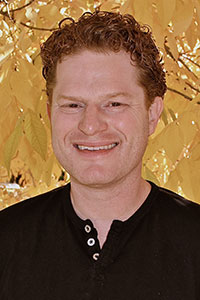Morgridge Investigator Randy Bartels is using optical imaging techniques to answer complex biological questions by observing phenomena that have previously been difficult to capture.
In new research published in the journal Optica, the Bartels Lab and collaborators describe a new approach that looks into biological samples to uncover hidden information within cells and tissues.
The researchers demonstrate for the first time the use of third harmonic generation (THG) holographic microscopy — where the frequency of laser light is tripled when it interacts with materials — to collect measurements of light intensity as well as phase information.

“Third harmonic generation phase has never before been directly measured,” says Yusef Farah, a postdoctoral researcher and first author of the published work. “With this information, we can unlock new material properties or solve problems to generate three dimensional images. This opens up the possibility of new applications in biomedical imaging and material science.”
Light radiates in oscillating waves, forming peaks and valleys that represent the intensity of light. Those waves can phase shift as the light interacts with and reflects off the material through which it is moving.
Bartels explains that most everyone has probably observed this phenomenon without realizing it.
“Caustics in the bottom of a swimming pool — those dancing lines of light moving around,” he says. “When there are ripples at the surface, the light going into the water gets distorted and the phase variation ends up focusing into certain points.”
The researchers suggest that phase information can provide additional details about cellular structures, tissues, protein aggregates, lipid cells, and other fundamental biological structures when imaged with THG holography.

“We don’t really have anything to compare our results to because nobody has really done this yet,” explains Farah. “So we’re looking forward to testing our microscope now on new samples to unravel what does phase information from samples truly give us?”
In this study, they demonstrated image reconstruction of different sample types: collagen fibers within a mouse tail cross section, osteoblast cells in developing bone, and monolayer molybdenum disulfide, a two-dimensional semiconductor.
THG holographic microscopy uses a non-linear approach to convert lasers from one color to another — infrared to ultraviolet — interacting with the properties of the molecules inside a cell or tissue to create contrast used to generate an image.
“It turns out that fundamental conversion process is sensitive to extra information,” says Bartels. “This allows us to access information about the way cells and tissues are organized, which could lead to new way of studying and detecting disease.”
Additionally, THG microscopy is a label-free imaging approach, meaning biological samples do not need to be tagged or stained with fluorescent markers that are often toxic.
One promising application of this technology is to perform rapid assessments of tumors, to identify biomarkers of cancer within the cells of a biopsy sample. Instead of needing to wait a couple days to prepare and fix slides for histopathology, this could be performed at a microscope in an operating room while a patient is still in surgery.
“Third harmonic generation phase has never before been directly measured. With this information, we can unlock new material properties or solve problems to generate three dimensional images. This opens up the possibility of new applications in biomedical imaging and material science.”
Yusef Farah, postdoctoral researcher
While phase can provide new information about cells, it also presents an obstacle to imaging — phase distortion. This is similar to the reason stars appear to “twinkle” to the naked eye, as irregularities like turbulence in our atmosphere distort the starlight. Telescopes correct for these distortions using what’s known as “adaptive optics.”
“We adapted techniques developed originally for astronomy to be used for microscopy,” Bartels says. “We developed algorithms to figure out what these phase distortions are, and then apply corrections to go from kind of a junky image to a good image in the end. That was the key to getting reliable information.”
This research is currently in Phase 2 of funding from the Chan Zuckerburg Initiative, with future plans to look at simpler ways to capture this data and developing solutions to modify existing imaging setups.
Currently, the lab uses a homebuilt laser, but they want to identify which laser sources would improve imaging speed and image acquisition. And ultimately, Farah says their goal is to make their THG system accessible for all users.
“Ideally, a biologist could fire up a laser with one button and start collecting images rapidly,” he says. “Make it fast and easy.”
